#it's in the source code of like 90% of the websites out there as a default pfp
Explore tagged Tumblr posts
Text
only real ones understand the new pfp
#for those who don't#it's in the source code of like 90% of the websites out there as a default pfp#ramblings
4 notes
·
View notes
Note
your oc website is SO SO SO SO INCREDIBLY COOL how the hell do you even start learning how to do this ?? if you learned how to do this by yourself online, are there any tutorials or resources you can share with us? was making this website free??
omg THANK YOU SO SOOOOOO MUCH!!! It makes me so happy to hear that folks like my little site. I code my site with Phoenix Code (for the live viewer and number dials) and I host my site on Neocities - it is all free. Phoenix can be used in browser or on desktop, but I like having it on desktop more for big projects in case my files get deleted. I use the browser version when I just want to test something quickly.
The 2 videos I use and can not recommend enough to anyone who asks me are this HTML tutorial and this CSS tutorial. They are simple and easy to understand, but I recommend watching it the first go, and then following along the next few watches until you get the flow of basic parts to a website, how they're organized, and what order they go in. At this point, I've memorized exactly where everything goes, and it is all thanks to these 2 videos.
If I am being honest, I learned how to code by myself, not quite even with online tutorials but just from being stupid and messing around myself (1, because I was a kid, and 2, because I didn't understand English very well to know what tutorials are saying.) I used to do html coding for Neopet pages when I was a kid with too much online time, first by just editing the default petpages and adding info and images, and then just doing trial and error with the html. I'll just try something and then if it doesn't turn out the way I want it, I try to find out why it didn't work and also get inspiration from other similar sites to figure out where things go or how they coded (with this nifty thing called right click > inspect page or right click > view page source). And BOOM, working webpage.
It was rudimentary, white blank background without any boxes or anything, you just scrolled down the page and sections were separated by a horizontal bar. OH and every text was centered! I had no idea how to make scrolling boxes or fancy assets, but damn I still had so much fun working on it every weekend. When you find authentic selfmade sites from the 90s and 2000s, most of them aren't super fancy either unlike what modern nostalgia makes you think. So I hope you don't feel discouraged if you begin making a website and feel it isn't "fancy", you're already doing a first big step which is making a webpage and learned your first set of html code!
It was over a decade later before I coded webpages with html again. I've gotten lazy and started relying on site builders, but nothing was quite as versatile as html. I wanted to try coding my own OC site again, so that was when I started working on OutKrop (the site I posted). Until I started coding again, I had literally no idea what CSS even is (and let me tell you, it's a game changer!)
Personally, I work best when I can do things hands on. I don't read through tutorials, I code first then go back and read through coding help sites like w3schools when I find myself stuck and unable to figure something out. Sometimes I grab existing codes and play around with them to see what changes and what I can do with it, cuz having visual context is what helps me a lot.
I can also share my process:
Once I gather up some ideas, I make a sketch, including what boxes (divs in css) should approximately go. It is very rough, but shows me exactly what I need to know.
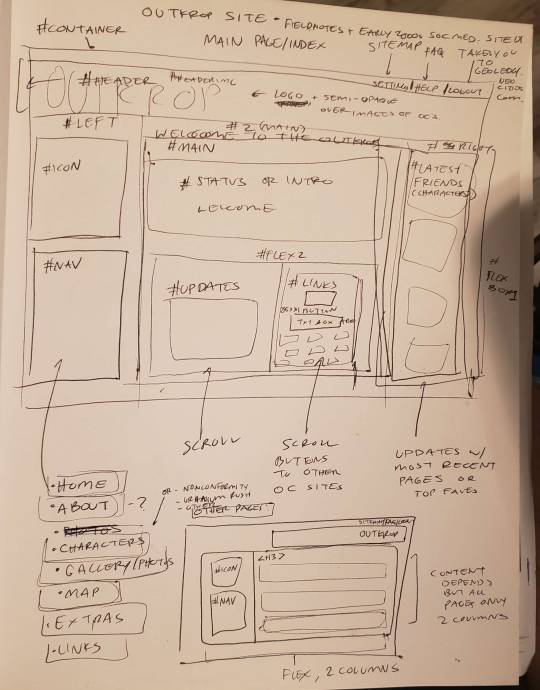
Next I load up my coding app (Phoenix Code in my case) and "sketch" the layout. Nothing fancy going on here, just putting things where they need to be, and fixing size of boxes and margins if needed. I give my boxes all a background color so I can easily see how big they are and where they are located.

After some adjustments like moving stuff around and adding assets like backgrounds and images, and changing colors of the boxes, rounding off corners, etc., we get this!
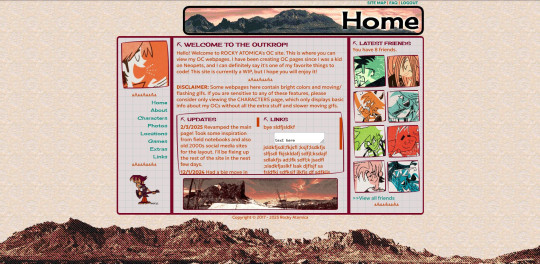
so recap + additional useful sites I use:
Coding app: Phoenix Code
Site hosted on: Neocities
Video tutorials: HTML and CSS
Sites for learning code: w3schools, also lissa explains is a great site that is written for kids to learn html so it's easy to understand. Finally, sadgrl has a lot of great resources for coding as well!
I recommend looking through these sites AFTER you tried taking a spin at coding - it doesn't have to be anything fancy just follow the HTML video tutorial I linked!
Thanks for the ask, and I hope this helps you and many others out there who are interested in building a site with html/css! Don't be afraid to get things "wrong" or have an "un-fancy" site. This is how you learn to code, and it'll become so easy once you get the hang of it.
Anyone is always more than welcome to reach out for coding help and advice :-]
59 notes
·
View notes
Text
Colors!
My thumb's been fucked up by a steroid shot to the point where I can't hold a pen to draw, but the light touch of a watercolor brush is mostly okay, and I had dot cards for Daniel Smith and DaVinci paints, so I've spent the last few weeks unleashing my manic color goblin.
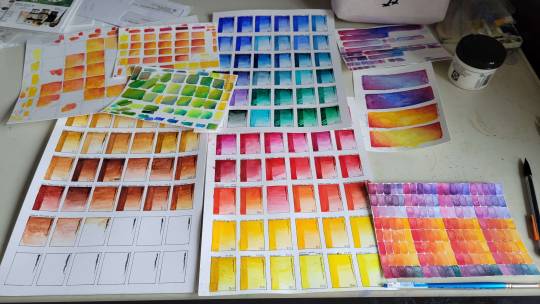
Friends, I've painted so many happy little rectangles. And it has been a journey.
I've found that one of the most-referenced sources for pigment lightfastness is a hard-coded website straight out of the 90s that also talks about UFOs and human evolution. (I don't know what the guy says about human evolution, because I'm afraid to find out, but it makes me very happy that a site like that still exists).
I've learned you can make lovely purples with a cool red and phthalo green, which actually MAKES SENSE, I GUESS, but is still a bit weird and awesome even though I understand the color theory.
I've painted with the Danger Colors.
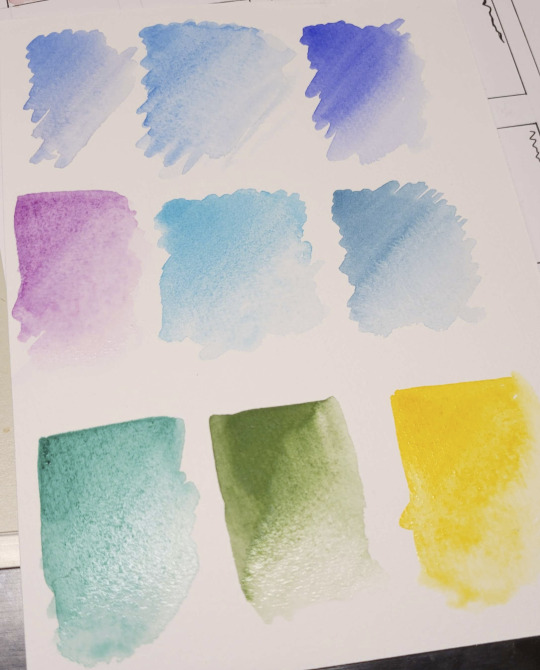
(Cobalt, manganese, chromium, and cadmium. DO NOT LICK).
I've finally spelled phthalo often enough that I can remember it!
And I've fallen deeply, desperately in love, then had my heart broken.
It's name was DaVinci Phthalo Turquoise (pigment code PB16). When I painted it out it was beautiful; smoothly flowing into a perfect fade, the deepest, most inviting pool of cool, saturated perfect teal. I burst into song. A choir of angels descended to sing backup vocals. I never used to believe in love at first sight, but I was wrong.
...then it dried.
It dulled so much. It was still fine. Nothing special, but fine. Whatever. I'm over it. I am a strong, independent artist. I don't need that kind of negativity in my life.
There's still all the other colors. Colors that didn't betray me. Much.

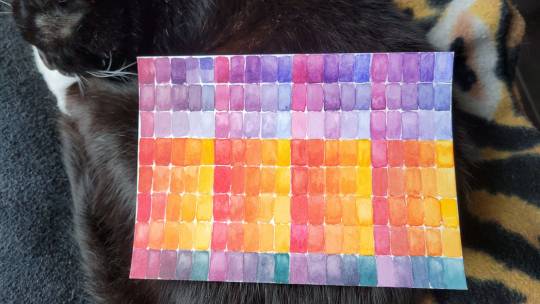
Here, Monkey is helping model the last swatch tests, which helped me choose which cool red to buy. The phone doesn't capture all the nuance, but they also started out fairly close. (I went with column 3, DaVinci's PV19 quinacridone rose madder).
So... if you're one of those tenacious, patient people who follows my fic, and you've been wondering why I haven't posted, I suppose I really just have one thing to say:
Colors go brrrrrrrrrrrrrr.
#watercolor#pigments#painting#color swatches#so many colors#so satisfying to line them up in rows#colors go brrrrr#Shades makes art#?#traditional art#danger colors#mmmm cobalt
33 notes
·
View notes
Text
Mediocre Extras in Drowned God: Conspiracy of the Ages Re-release Leaves Price Questionable
Since the Epic Games Store doesn't let you review games and it's not on Steam yet (a release there is supposed to happen eventually), I'll have to make my review here.
Some of my followers may recall that when the 90's point-and-click adventure game Drowned God: Conspiracy of the Ages was illegally put on Steam for $15, I raised the alarm about it to get it taken down. As I came to learn later, this incident inspired the rights holders (producer Algy Williams, co-creator Alastair Graham, and creator Harry Horse's estate) to come together and produce a re-release that is currently on the Epic Games Store for $25.
Since the original source code was lost long ago, all the developers could do was polish it slightly to make it run better on modern computers and hopefully iron out the bugs, but to justify the price point the advertisements on the new website promised several enticing extras including: a new walkthrough, the original pitch documents, an all-new art book with never-before-seen art, and most exciting of all - Diary of a Plagiarist, the 11-volume tome Harry Horse created in the 80's that served as the inspiration for Drowned God but was thought to have been lost (well, not really lost, the guy Harry sold them to refused to sell them back).
When I brought up the illegal version of DG on Steam, I said then that the game by itself would not even be worth $15 even if it were an official re-release because 1. It's a short, linear point-and-click game 2. It's over 25 years old now. Do the extra materials make the $25 price tag worth it? I'm not so sure, right now I'm leaning towards "no, not really". I'll tell you what's in this package and you can decide for yourself.
First, the game, which is fundamentally the same as it was before. This is not a remake or a remaster, there are no subtitles to alleviate the often awful audio mixing, it's just the original game made easier to play now. The producer of the re-release said in a Q&A video on the DG Youtube channel that he thinks the audio mixing sounds a little better now than it did then, but I couldn't tell you because my Airpods broke recently and I had to play the sound through my potato laptop's speakers.
Well, at the very least, from what I've played of the re-release so far (I'm not planning on playing through the whole thing right now, I'm not strong enough to go through that goddamn 9 Men's Morris puzzle again, I'm sorry ;_;), it is indeed functional and the mouse sensitivity felt better from what I remember playing on my emulated version.
So the re-release delivered the bare minimum with the game, and if that's all you care about and don't mind spending $25 on it, have at it, but now onto the extra materials, which I feel are a mixed bag that wouldn't have been so disappointing to me if the advertisements had been more honest about what they contained.
I have no qualms with the new walkthrough and the original pitch documents. The former is made to look like a top-secret folder complete with bits of redacted text and handwritten notes, it's very cute. The latter is very interesting to those interested in the lore of the game, as it gives a very different picture about what the story could have been. There are many pieces of art and writing that depict very different scenarios for the player that were changed for the final release, such as a description of the original goal being to collect a key plus several pieces of a UFO to fly to Atlantis and raise it from the ocean, with no mention at all of Kether and Malchut.
As for the other main extras, I have my qualms. Firstly is the purported Drowned God Art Book, which isn't really a book at all but a booklet, a short collection of concept art and musings from Alastair Graham about Knights Templar and Mayan mythology that abruptly stops and mostly only shows art from the Binah section of the game.
Don't get me wrong, the concept art that actually is in there is great, but I was left wanting more. If those pieces of art that were there were all that the developers had managed to track down after all these years and they titled the collection something like "Drowned God Art Booklet", I would understand, but they oversold the art "book"'s contents by a long shot, I feel.
And I know for a fact that there's more artwork out there that for whatever inexplicable reason wasn’t included anywhere in this re-release, but I can’t go into more detail at the moment, I’m in the process of trying to find out what’s been going on with this topic and will hopefully be able to give an update on it in the future.
As for the "Diary of a Plagiarist", that was a straight-up lie. It's in fact just a handwritten letter from Harry Horse giving the premise, a few story details, explaining how and why he made the volumes, and apologizing that he couldn't remember a whole lot about what was in them because he could never get them back. Imagine paying 20-something bucks for what you think is a copy of Moby-Dick, only to open it up and just see a note from Herman Melville going "I think it was about a guy in a boat chasing a whale, I forgot, lol".
I'm glad we have these notes from Harry in this case because it's probably the most detailed information about DOAP that we're ever going to get, plus it has more concept art of what looks like an even earlier version of DG before the pitch documents. However, the ones who put this re-release together could have avoided pissing me and potentially other people off by just being honest about what it really was rather than pretending like it's the real deal on the website.
So what we've got here are a few pretty good pdfs that have been blown out of proportion in terms of their contents. If you think that plus the old game is worth $25 and you can spend that, go right ahead, but for the rest of you, I would recommend waiting for a sale.
I have a few ideas for what they could add onto the package in the future to make it more worth the price tag: 1. Include a text file of all the spoken dialogue and hard-to-read pieces of writing in the game for those who might need it. 2. Expand the art book to include interviews from the developers about the making of the game and put in those other pieces of art that weren’t there the first time. 3. Update the website and social media to be more honest about the contents of the extras. 4. If tracking down the creators of the game's soundtrack is feasible, create a new, remastered soundtrack that makes the music longer than the original short loops.
If they cannot add any of these things in the near future, then there is really no excuse for this to be $25. Other PC games that are about as old as Drowned God such as Fallout 1 and 2, Diablo 1, Half-Life 1, Quake 1, and more are not only much cheaper to buy, but have more to offer.
#drowned god conspiracy of the ages#90's games#point and click adventure games#retro gaming#pc games
5 notes
·
View notes
Text
Hey, party animals. I'd like to make my pitch for you to back "Free Stars: Children of Infinity" on Kickstarter.
youtube
This is a sequel of a 90s-era DOS classic (Star Control II: The Ur-Quan Masters), developed by an indie studio composed of many of the original game's creators (who managed to regain IP rights). The franchise was a favorite of mine, growing up, and I'm excited to see a proper continuation of its story finally on the horizon.
You may be confused as to why I'm suggesting you back a game that Kickstarter claims is already "fully funded". Isn't that just a preorder with extra steps? Isn't "never preorder a game" a lesson we've learned painfully, hard knock by hard knock?
The reason is: if we fund this game enough that the developers don't have to worry about how they'll afford to make their next game… then two years after release, they'll open source it.
…we talk plenty about game preservation on this website. About the necessity of "circulating the tapes", copyright law or no, to avoid the creative works we love becoming lost media.
But the other side of that equation is that, for a video game, you don't just need to preserve the game itself; you also need to preserve something it can run on. You either need an emulator for the kind of computer that existed back then, or a port to modern hardware. And the best way to ensure that "a port to modern hardware" is possible… is to have the code available, open sourced, and replicated across all the dozens of Linux package managers out there.
Backers may have already funded the development of Free Stars: Children of Infinity. But we haven't bought the game yet. To fully buy it off? To free it for the world? 10% funded.
I'd like to ask you to consider backing the game – even just as a $30 preorder – to help get that number to 100%.
Thanks for your consideration.
5 notes
·
View notes
Text
Michael Darling Through the Ages:
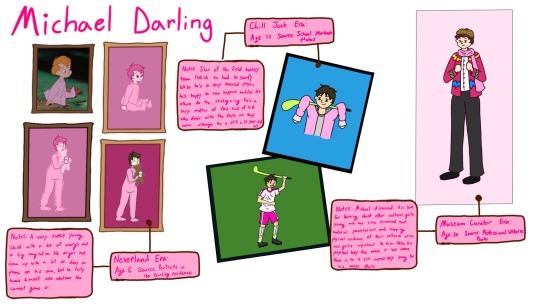
Finally finishing off the Darlings with this post and making it so painfully obvious that I'm color coding these characters that I will assume you lack color vision if you miss it. This is post number 4 for this project! I am making a crossover for Peter Pan, Milo and the Phantom Tollbooth, Alice in Wonderland, and The Wizard of Oz. The story will focus on all the main characters from these stories moving to the same town and going to school and having fantastical adventures together.
More info and non-formatted drawings under the cut. Posts for Alice, Wendy, John, Dorothy, and Milo.
Chicken Scratch Translation (in the order the boxes should be read):
[Neverland Era. Age: 6. Source: Portraits in the Darling residence]
[Notes: a very sweet young child with a lot of energy and a big imagination. He might not come up with a lot of ideas or plans on his own, but he fully throws himself into whatever the current game is.]
[Chill Jock Era. Age: 13. Source: School yearbook photos]
[Notes: Star of the field hockey team (which he had to start). While he's a very talented player, he happy to run support and/or let others do the strategizing. He's a very matter of fact kind of kid who deals with the facts as they come. . . Although he is still a 13 year old boy.]
[Museum Curator Era. Age: 30. Source: Professional Website Photo]
[Notes: Michael discovered his love for learning about other cultures quite young and has since discovered that material preservation and keeping physical evidence of their cultures alive was quite important to him. While his perpetual baby face makes it look worse than it is, he is still impressively young for his career choice.]
AU Info:
This is a modern!AU taking place somewhere between the 90s and the 2010s
The AU takes place in America, mostly because I am an American and will have an easier time that way. That said, Alice and the Darlings were still originally located in England and relocated to America sometime after their original adventures. Dorothy is from Kansas and Milo is from Indeterminate American Suburbia.
The school is 7-12. During the time of the story, Michael and Alice are 8th graders, John and Milo are sophomores, and Wendy and Dorothy are seniors.
I am using book canon for Alice in Wonderland (I will be using both Looking Glass Land and Wonderland) and for Milo and the Phantom Tollbooth. I'm using Warner Bros Movie canon for The Wizard of Oz. I'm using primarily Disney movie canon for Peter Pan, but will be taking elements from the boon and the stageplay as I see fit.
The story will be equal parts high school AU , focusing on their mundane adventures, and fantastical story, and all of the original Magical Otherworlds will be featured.
While this will be a gen fic, ships will appear! Wendy and Dorothy are both some kind of sapphic and will be shipped (they don't really know their own sexualities, but they do know they like girls). John is gay and Milo is aspec (exact variety as of yet undetermined) and will be shipped in an aspec way. Michael and Alice will stay single, but Michael is straight and Alice is pan.
These information files exist in universe! Who made them? That's my secret! >:)
Other Notes:
I can do what I want. The Darlings are 1/4 Japanese from their maternal grandmother.
While I tried to extrapolate the kids' future jobs and interests from their stories, Michael is unfortunately too young to profile. He carries a teddy bear and really likes Nana, so I was going to give him an animal related profession, but I changed my mind and decided to do something dumb instead. Type Michael Darling into a search engine and see if you can figure it out.
Unformatted versions:

#Project: The CrossRoads#giraffe's ramblings#fanart#Peter Pan fanart#Michael Darling fanart#which isn't a tag because NOBODY cares about this child but me#Peter Pan#peter pan crossover#Peter Pan fanfiction#crossover fanfiction#crossover#michael darling#i am very curious if that tag will attract anyone who isn't supposed to be here#if it does#hi hello i'm sorry that every search you make is probably like this#you know who you are#digital art#highschool au#modern au#i again expect this to stay a 0 note post#but some Peter Pan fanart nut surprised me last time so we'll see what happens#sorry for rambling in the tags again#but it's me and ya'll should know by now that this is just what i do#also i have no idea who the hypothetical you i'm talking to is since all these posts have like 2 notes and it's different people every time#but i digress#Giraffe's Scribblings
3 notes
·
View notes
Quote
However, researchers found that without high-quality human data, AI systems trained on AI-made data get dumber and dumber as each model learns from the previous one. It’s like a digital version of the problem of inbreeding. This “regurgitive training” seems to lead to a reduction in the quality and diversity of model behavior. Quality here roughly means some combination of being helpful, harmless and honest. Diversity refers to the variation in responses, and which people’s cultural and social perspectives are represented in the AI outputs. In short: by using AI systems so much, we could be polluting the very data source we need to make them useful in the first place. [...]Can’t big tech just filter out AI-generated content? Not really. Tech companies already spend a lot of time and money cleaning and filtering the data they scrape, with one industry insider recently sharing they sometimes discard as much as 90% of the data they initially collect for training models. [...]There are hints developers are already having to work harder to source high-quality data. For instance, the documentation accompanying the GPT-4 release credited an unprecedented number of staff involved in the data-related parts of the project. We may also be running out of new human data. Some estimates say the pool of human-generated text data might be tapped out as soon as 2026. It’s likely why OpenAI and others are racing to shore up exclusive partnerships with industry behemoths such as Shutterstock, Associated Press and NewsCorp. They own large proprietary collections of human data that aren’t readily available on the public internet. [...]A flood of synthetic content might not pose an existential threat to the progress of AI development, but it does threaten the digital public good of the (human) internet. For instance, researchers found a 16% drop in activity on the coding website StackOverflow one year after the release of ChatGPT. This suggests AI assistance may already be reducing person-to-person interactions in some online communities.
What is ‘model collapse’? An expert explains the rumours about an impending AI doom - Raw Story
2 notes
·
View notes
Text
This is so hard for me to accept and deal with but ugh. To be somewhat fair, there’s just something turbo-fucked about middle school boys’ BRAINS that a certain amount of them will inhale fascist, woman hating rhetoric from literally any available source for a few years before they HOPEFULLY get it out of their system and I don’t know why that is—the internet has just TURBOCHARGED their shitty tendencies. My middle school years were riiiiiiight as PCs were going mainstream, we were one of the first people in town to have a personal computer when I was in elementary school and my Dad knew rudimentary COBOL(he no longer does lol).
I still remember distinctly at least one kid who was…..suspiciously TOO INTO World War Two books and you reeeeeeeally got the overall impression the interest was more into the uhhhh Axis Powers. And myself running across one of many HUGE list of novelty websites—because pre-Google this and webrings is how you encountered shit, completely randomly—and one of them being THE FIRST WEBSITE FOR STORMFRONT IN THE 90’S. I remember my middle school brain thinking, “Hmm, I wonder what sort of rhetoric these sort of people use to justify their behavior?”, read their brief manifesto about ���white genocide”(their ideas seriously haven’t changed since the 90’s you guys, just the tactics), and thinking, “That’s the stupidest goddamn thing I’ve ever heard. They’re never gonna convince anybody with that.” Lol. Lmao.
So I will at least make the point that these fucks have always been here, and there’s something about middle school boys that makes a certain percentage of them veer into some manner of fash. But the algorithm takes whatever your id wants and just GIVES IT TO YOU ENDLESSLY. Before at least, that kid had to search for it and search for it and keep search for it—it was something he had to knowingly do.
Before, things were made and promoted organically by human hands. If something went “viral,” it was because a fuckton of people GENUINELY liked it and shared it. Now? An algorithm is a personalized corporate black box. Sure, it’s teased out your personal desires—and some of those desires are NOT in your best interest and you would not have naturally sought them out on your own!—but it’s attuned to the corporation’s desires as well. If the corporation doesn’t want you seeing something? You aren’t going to see it. They aren’t here to make the world a better place though and sit here and think of code and keywords of every Nazi slur—a corporation is literally here to make money. MAYBE they will if it’s bed enough you stop using the product(or more likely, YOU the PRODUCT stop allowing yourself to be used and your information to be sold), but not enough to care about some getting through now and then. If that corporation decides gay people or fat and ugly people don’t fit with their image—TikTok—then the algorithm suppresses it.
When I hear young people asking for AO3 to have an algorithm, I despair. I know it’s what they’re used to and the water they’re swimming in and they’re likely so unused to even the SKILL of searching for what they want, but you really really want a corporation deciding what’s best for you to see?
No, kids should not have unsupervised acess to the internet. Yes, I got that and it was the best thing that ever happened to me. Its a paradox.
261K notes
·
View notes
Text
Local SEO for Orthodontists: Get Found by Patients in Your Area
In a world where 90% of people search online before choosing a healthcare provider, being visible in your local area is no longer optional - it’s essential. For orthodontists, local SEO is one of the most effective ways to attract nearby patients who are actively looking for services like braces, Invisalign, or early orthodontic care.
Local SEO isn’t just about ranking on Google - it’s about showing up at the right time, in the right place, and with the right message to convert searches into appointments.

What Is Local SEO for Orthodontists?
Local SEO for Orthodontists is the practice of optimizing your online presence to appear in search results for geographically-related queries. For example:
“Orthodontist near me”
“Braces for teens in [City Name]”
“Invisalign South Hill WA”
Unlike traditional SEO, which targets broad keywords, local SEO zeroes in on patients searching in your city, neighborhood, or zip code — where most of your new business comes from.
Why Local SEO Matters for Orthodontists
When someone nearby searches for “Invisalign provider in Morristown,” you want your practice to be the first one they see. That’s where Orthodontics and Dental SEO Services play a vital role. Local SEO helps:
Increase visibility on Google Maps and local search
Drive qualified traffic from people actively seeking treatment
Build credibility through reviews and business listings
Outrank competitors who aren't optimizing locally
It’s one of the most cost-effective ways to attract consistent leads without relying on paid ads.
Key Components of Local SEO for Orthodontists
Here’s what goes into an effective local SEO strategy:
1. Google Business Profile Optimization
Your Google Business Profile (formerly Google My Business) is the foundation of your local SEO presence.
To optimize it:
Ensure your NAP (Name, Address, Phone) is consistent
Select accurate categories like “Orthodontist” and “Invisalign Provider”
Add photos of your office, staff, and before/after results
Include your services (e.g., clear aligners, metal braces, early treatment)
Post weekly updates or offers
Bonus Tip: Encourage happy patients to leave 5-star reviews regularly — Google rewards active profiles.
2. On-Page SEO with Local Keywords
Your website needs content that targets your location and your services. This includes:
City-specific pages (e.g., “Orthodontist in Parsippany NJ”)
Location-based blog posts (e.g., “Best Age to Start Braces in [City]”)
SEO-friendly headers, title tags, and meta descriptions
Embedding maps and contact info on key pages
Use long-tail phrases like:
“Affordable braces near [city name]”
“Invisalign for adults in [neighborhood]”
3. Localized Content Marketing
Educational content that targets local searchers builds both trust and visibility. Some ideas:
Blog: “What to Expect at Your First Orthodontic Visit in [City]”
FAQ page: “Do Braces Hurt?” + mention your local practice name
Success stories from real patients in your area
Videos answering common local questions
Google loves hyper-relevant content — and so do your potential patients.

4. Citations and Local Listings
Your practice should appear consistently across top online directories. Examples:
Healthgrades
Zocdoc
Yelp
Facebook
Local Chamber of Commerce websites
Consistency is key: Your business name, address, and phone number must be identical on every listing. Mismatches can hurt your rankings.
5. Mobile-Friendly Website Design
Most orthodontic searches happen on mobile. Your site should be:
Responsive (fits all screen sizes)
Fast-loading (under 3 seconds)
Easy to navigate with clickable phone numbers and “Book Now” buttons
Optimized for local keywords in URLs, headers, and image alt text
6. Local Link Building
Backlinks from other trusted local sources help build authority. Reach out to:
Local dental blogs or news sites
School sponsorships or sports teams
Community event listings
Referral partners (e.g., pediatric dentists)
These not only improve SEO but also build real-world trust.
The ROI of Local SEO for Orthodontists
Local SEO is a long-term strategy that continues to generate leads month after month, unlike paid ads that stop when your budget does.
Practices that invest in local SEO typically see:
Higher search visibility
Increased appointment requests
More 5-star Google reviews
Better patient retention and referrals
Ready to Rank Higher in Your Area?
At Ortho Marketing, we specialize in local SEO for orthodontists — from technical site audits and content strategy to Google profile optimization and review generation.
We understand what your patients are searching for, and we help you show up right when they need you.
Let’s talk about how to grow your practice with local SEO. Contact us today for a free audit.
#localseo#orthodonticmarketing#orthodontistseo#dentalmarketing#orthodontistmarketing#seofororthodontists#orthodontistwebsite#localmarketing#digitalmarketingfordentists#orthodonticpracticegrowth
0 notes
Text
0 notes
Text
I was only about to scroll past this so many times, so:
Doom doesn't draw fucking triangles. GPUs draw triangles because it makes sense to build a GPU to do one specific thing! That way they can do it in parallel and very quickly. So GPUs specialize, they only do triangles. Need to draw a square? Use two triangles. A hexagon is like 4 triangles. A circle? Well, pick some number, draw that many triangles. They can draw millions per second, so the fact that it's less efficient to draw a square as two triangles doesn't matter.
Doom... Is not remotely like that! It's from 1993! Triangle-shoving GPUs? That's a late-90s thing.
Doom is a 2d renderer. It has no hardware acceleration, and it's drawing individual pixels in software.
It uses some BSP/raytracing math to figure out where the walls are, and draws them A SINGLE PIXEL AT A TIME individually. Like, one wall at a time. It uses some careful math to minimize overdraw, because it is expensive to waste time covering up what it already drew. The floors and ceilings are arbitrary polygons... Which it draws horizontally, no triangles involved.

(Image from Fabien Sanglard's website. They wrote the Doom Programming Black Book)
See? It's all individual pixels. This required a LOT of very smart programming just to get this shit to run at 35 frames per second on computers at the time. This is amazing for the time, sure, but it's a mess. You could only make Doom in 1993 because you had one of the greatest programmers of all time working on it. That's great for Doom, but these days you can make 3d games without a genius on your team: BECAUSE WE HAVE GPUs.
This actually makes Doom hard to run on modern hardware. It wants to use the CPU to draw individual pixels, and modern GPUs want triangles. It doesn't know triangles. Sure you could use our new faster CPUs to just do it the old way, but that means your GPU is idle. Your GPU is supposed to make this faster, right?
So a LOT of work has been done by clever people in the 28 years Doom has been open source, and they've figured out how to write a whole new triangle based renderer on top of the old doom code. It uses triangles, of course!
(fun fact: the floors and ceilings are the hard part. The walls and sprites? Easy. Two triangles each, apply the right texture, and you're done. Floors? Those are arbitrary polygons. Not even convex polygons, either. So there's a whole thing with triangluating the floors in a way that makes it into proper triangles that isn't too slow to do at level load)
But that's the modern source ports only. Gzdoom and descendants.
The old doom, even some of the slightly modernized dooms like chocolate doom? They have no triangles, just CPU-calculated individual pixels.
Anyway, my point is, if you want to "run Doom on some kindergarteners", you only need big grid paper and some crayons. Tell them where to draw the walls, then the floors and ceilings, and you're done. No triangles needed. It's all paint by number.
Anyway: I know this because I'm actually planning to do it. Not with kindergarteners, mind you (I have none on hand), but Doom could be run "on a" human with paper and pencil, and I'm working towards doing that. It'll take a long while per frame (so I'm only going to do one), but I'll have to do a bunch of math on paper and then color in some grid paper with a large pile of colored pencils. But what I won't have to do is DRAW ANY TRIANGLES.
Kindergarteners will be so proud of themselves for being able to draw a triangle. My GPU can draw tens of thousands of those in a second. You are not special.
54K notes
·
View notes
Text
if you google "when is 4chan coming back" 90 percent of the results on the first page will be news agencies confidently stating 4chan likely isnt coming back, most of those articles from the day of the hack itself. this is very unusual to say the least, and as i pointed out yesterday despite the language being used about the hack "the source code is leaked!" the site should absolutely have been back up and running within twenty four hours there is nothing really all that special about this hack whatsoever
they shut it down. its sad but man i wish i could hit this with the gravitas it deserves, SORRY NOT SORRY. i openly told you fuckers again and again, if you just STOP LYING about Jesus and Hitler you would never hear from me again, i meant it to thats all you had to do, but apparently you couldnt handle it if we cant have a 4chan without kikes lying on Jesus and Hitlers holy names, well fuck your website then i dont give a shit
the idea that soyjack party did this "hack" or that they were a "Rival board" is absurd beyond all description, because EVEN NOW with 4chan having been dead for several days all those rival websites which now are peoples ONLY option are still basically fucking dead. saying soyjack party hacked 4chan is like saying Mossad infiltrated the CIA its like putting a pissing section in a swimming pool. there is not membership for these forums, the people responsible for the hack as ive already said were the same people responsible for shilling the boards to DEATH day in and day out, they were the moderations teams themselves
NOTHING came out of this hack whatsoever, the rumors about .gov domains for the mods are untrue (obviously) the geodata claiming to show israel is the main source of traffic for the website are fake. nothing came out, nothing fun happened and there was NEVER a legit community at soyjack party and if you go back to the date of the antioch school shooting on my blog you will see i ALREADY had called that website out for glowing, its a fed op. basically imagine websites like soyjack party and 4chan are "countries" on the world stage, the shills who moderated and ran 4chan are an "international rootless clique" they dont have loyalty to fucking 4chan or reddit or whatever, they yeeted their own website and claimed to be part of a nonexistant community from a dead website. thats it mang.
0 notes
Text
Tried to change the background color to this blog...
I decide I'm really set on this color pallete, because look at it! it's adorable! And I want the lightest green to be the background color for visibility. Wayyy less harsh than #FFFFFFFFF white.
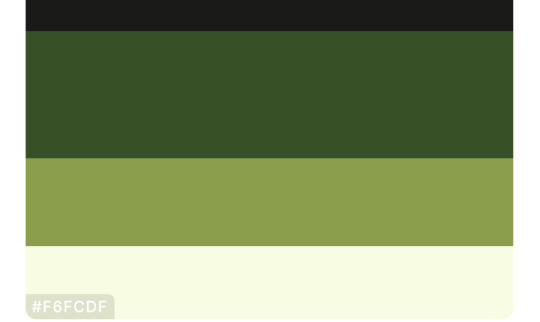
For some reason the standard background is bright freaking white (#FFFF, classic) and there's no built-in button on tumblr to change it like your font or accent color.
I go into the HTML, real tempted to say fuck this shit, but then I pull myself up and decide that it shouldn't be that hard. I've done python! I was a CS major for at least two minutes (3 semesters) so this should be easy as pie, right?
Wrong- I go through the documentation, a couple quora posts, and half of a tumblr blog specifically related to my question. Try all of their suggestions. Nothing seems to work. it's hopeless. Eventually, I hopelessly change 'background color' (seen below)

to the color I want. like so:

I say great! I hope this works!

Okay,,,,,, it's still bright white. Amazing. Cool. Add the hexcode hashtag back maybe?


........ nope.
.....fuck
So I end up searching the entire HTML code for where the fucking backgroundcode variable is identified, find nothing.
Eventually, I sigh loudly enough about it that my dad comes over and asks me about it. We've just been chilling on the couch, he's been watching basketball. Its been chill, excluding the pain I'm in about this blog background color.
I suddenly remember that he's literally a current software engineer (maybe doesn't use HTML) who used to make websites for people with my mom (DEFINITELY USED HTML). So I ask him to help, and he gets me to cast my laptop screen to the tv for a bit before (not unkindly) yanking my laptop away for a bit to search for the variable himself.
He ends up going through 90% of the same steps I did. He has't played with HTML in like, 10 years, so he's rusty too. Eventually, 10 minutes later, he says "fuck it, what if we just do this".
(for non-coding folk, the only difference is a lack of brackets)

.... processing

...no fucking way.
ANYWAYS, quick lesson that sometimes we make shit way harder in our heads than it needs to be. I'm also sure there was a better source on how to do this out there, but google was being unhelpful today, so we made do with using our brains instead. Not that it was much faster, but. whatever.
Anyways, quick PSA on how to change the background color of your blog I guess. Grab a hex code and don't spend half an hour of your life on it like I did!
Moving on, this is going to be my writing blog. I want to get back into writing because it has felt inordinately hard lately to write anything more than 2 sentences at a time for any reason at all. So like,,,, look forward to that I guess!
#html#I don't usually code butshould have known better probably#remember to ask your dad for help when you can because sometimes he does actually know the answer#mine took a moment but he still helped a LOT#so go ask your dad stuff and learn things from him#i'm sure he'll appreciate it#give him a hug too#anyways#background color#tumblr blog#writing#writing blog
0 notes
Text
How to Check Your Delhi Traffic Challan Online
In a bustling city like Delhi, it is not uncommon for individuals to receive traffic challans for various violations. These challans can be a source of inconvenience and frustration for many, but it is important to take responsibility for our actions and pay them on time.
According to the latest statement from the Delhi government, any traffic infractions must be addressed within 90 days of receiving the first notification for a current ticket, or within 30 days for any subsequent tickets issued after the first notification. Not complying with this timeframe could lead to a higher penalty fee.
Previously, the procedure of verifying and settling traffic fines in Delhi was arduous and took up a lot of time as it required physically going to traffic police stations and waiting in lengthy lines. However, thanks to technological progress, the process has become more effortless - you can now conveniently check and pay your traffic fines through online means.
If you have several pending challans associated with your name, all of them will appear on the website when you provide your vehicle number. Be sure to settle all the outstanding challans to prevent any potential inconvenience in the future.
When verifying your challan on the internet, ensure that you have your vehicle RC, insurance documents, and PUC certificate handy, these papers may be necessary as evidence of ownership or information about your vehicle.
*Roadside assistance app : https://www.lawyered.in/ guides you through the step-by-step process of checking your Delhi traffic challan online…
Step 1: Visit the official website
To begin, go to the designated webpage of the Delhi Traffic Police, which is https://delhitrafficpolice.nic.in/. This site contains all the essential details regarding traffic guidelines, laws, and fines. It is a user-friendly platform that can be viewed on any electronic device with internet access.
Step 2: Navigate to the ‘E-Challan’ section
After accessing the website's main page, find the 'E-Challan' category. It can be found on the right side of the page, below the 'Services' tab. Select it to continue.
Step 3: Enter your Vehicle Number
Once you click on the 'E-Challan' section, a new page will open with multiple tabs at the top. Choose 'Check Challan Status' tab, input your vehicle number, which can be either your registration number or engine number.
Step 4: Enter Captcha Code and Search
After you input your car's identification number, captcha code is required to be entered the displayed on the screen. This step is necessary to confirm that you are a real person and not an automated program. Finally, click on the 'Search' button to proceed.
Step 5: View and Pay your Challan
If you have any outstanding fines, they will be shown on your screen with information such as the date, time, and place of the offense, as well as the required payment. You can opt to settle the fine using different electronic payment methods.
Step 6: Print or Download Receipt
After making the payment, you will receive a digital receipt on your registered email id and phone number. You can choose to print or download this receipt for future reference.
If you come across any differences in the information shown on the site, like an inaccurate date or place of offense, it is recommended to reach out to the traffic authorities at 011-25844444.
They will assist you and address any concerns you may have. To sum up, the process of checking and paying your Delhi traffic challan online is easy and efficient, providing a time-saving solution. It is crucial to acknowledge our actions and promptly pay our challans to promote road safety and efficiency. Hence, it is advised to refer to the mentioned guidelines and make online payments when receiving a traffic challan. Stay safe and drive responsibly!
0 notes
Text
📚 Web Archaeology: Just discovered a digital time capsule!
Found this gem - the Cover Pages website (last updated 2006) that's been frozen in time since the 90s. It's like stumbling upon ancient digital ruins! 🏛️
Checking out the source code was like reading hieroglyphics of early web development. Table layouts, basic HTML - this was cutting-edge stuff back then! Amazing to see how far we've come from these digital foundations.
Fascinating how this site represented a major milestone in web development history, bridging early markup technologies into the modern era. Every element tells a story of how the web evolved.

1 note
·
View note
Text
How to Save Money by Buying a Used Engine Online
If you're looking to replace your car's engine without breaking the bank, buying used engines online could be one of the smartest decisions you make. Purchasing a new engine can be incredibly expensive, but going the used route gives you the performance you need without the high price tag. With a little bit of research and know-how, you can save a significant amount of money. Let me walk you through some of the best tips for saving money when buying a used engine online.
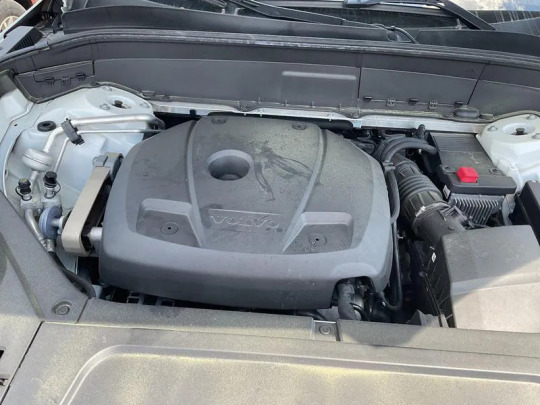
1. Research, Research, Research!
Before making any purchase, it's important to do your homework. Not all used engines are created equal, and you want to make sure you're getting the best deal. Look for reputable sellers with good reviews, and make sure the engine you’re buying fits your specific vehicle's make and model. The last thing you want is to get an engine that doesn’t work with your car. Compare prices on multiple websites to ensure you’re not overpaying. Many online retailers offer competitive prices, and you might find that shopping around could save you hundreds, if not thousands, on your used engine purchase.
2. Check the Engine’s History
This is a big one. You wouldn’t buy a used car without checking its history, so why would you buy a used engine without knowing where it came from? Look for engines that come with a detailed history report. This report should tell you the mileage on the engine, any prior issues it may have had, and whether it’s been rebuilt. Engines with fewer miles and a clean history are likely to last longer and give you fewer problems in the future. This step alone can save you a ton of money in repairs down the line.
3. Ask About Warranties
Even when buying a used engine, some sellers offer warranties, which can provide peace of mind. You should always ask about any available warranties or guarantees on the engine. A short-term warranty, even if it’s just 30 to 90 days, can be a lifesaver if something goes wrong after installation. A warranty could save you from unexpected repair costs if the engine turns out to have hidden problems. Always prioritize sellers who offer some form of warranty on their used engines.
4. Consider the Shipping Costs
One thing that people often forget about when buying a used engine online is shipping costs. Engines are heavy, and shipping can add up. Some retailers offer free shipping, so keep an eye out for that option. In other cases, it may be more affordable to buy locally if you find a seller near you who allows for local pickup. Always factor in shipping when comparing prices so you don’t get blindsided by additional costs.
5. Know What You Need
Before you even start shopping for a used engine, make sure you know exactly what you need. There are different types of engines, and some may not be compatible with your vehicle. Take down your car’s VIN number, engine type, and any other specific details to ensure you’re getting the right part. Making a mistake here could cost you more in the long run. The clearer you are on what you need, the less likely you’ll have to deal with costly returns or wrong orders.
6. Look for Discounts and Deals
Who doesn’t love a good deal? Many online platforms offer seasonal discounts, bulk purchase deals, or promotional codes that can bring down the cost of your used engine. Keep an eye out for flash sales or subscribe to seller newsletters so you can be the first to know about any discounts. A simple promo code could save you a chunk of money!
7. Don’t Forget Installation Costs
While the main focus is on saving money by purchasing a used engine online, don't forget about installation costs. Once you receive your engine, you’ll likely need a mechanic to install it unless you're doing it yourself. Ask for quotes from local mechanics before you buy so that you can budget for installation. Sometimes, a mechanic may even be able to help you source the engine, saving you even more money.
8. Avoid Scams
This might seem obvious, but it's critical when shopping online. There are plenty of reputable sellers, but unfortunately, there are also scams out there. If a deal seems too good to be true, it probably is. Make sure you are buying from trusted sellers with good reviews. Also, double-check the seller's return policies and read the fine print to avoid getting stuck with a bad engine. Stick to well-known platforms or websites that have customer protection policies in place.
9. Use Forums and Groups for Recommendations
Car enthusiast forums and groups can be a goldmine of information when you’re shopping for a used engine. People who have been in the same situation can point you to reliable sellers, recommend where to find good deals, or even warn you of sellers to avoid. Getting personal recommendations can sometimes be more reliable than reading through seller reviews, especially if you're new to buying car parts online.
10. Buy from Certified Sellers
When possible, try to buy from certified sellers or suppliers. Some sellers specialize in reconditioned or tested engines and offer more thorough quality control than private sellers. Certified engines often come with a bit more assurance that you’re buying something that has been inspected and is in good working condition. Yes, they may cost a little more upfront, but they can save you from the risk of buying a faulty engine, which could end up costing more in the long run.
Conclusion
Buying a used engine online is a fantastic way to save money, but only if you do it right. By following the steps above—researching your engine’s history, looking for warranties, considering shipping costs, and being mindful of scams—you can ensure you’re getting a great deal without sacrificing quality. When done correctly, purchasing a used engine online can be one of the best investments you make in your vehicle, saving you money and keeping your car running smoothly for years to come
0 notes